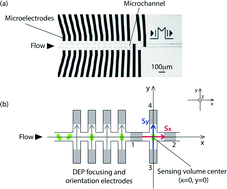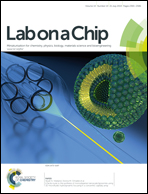An impedance-based flow microcytometer for single cell morphology discrimination†
Abstract
Cell shape is a fundamental biological feature, providing specific information about physiological or pathological cellular conditions. Most of the state-of-the-art microfluidic cytometers, however, only allow simple cell analysis, including viability studies, cell counting and sorting. In this work, we present a non-invasive, label-free device capable of single cell morphology discrimination in continuous flow. The device is based on the principle of liquid electrodes, fabricated in a cross configuration around a sensing zone. This arrangement allows measurement of cell impedance along orthogonal orientations and extraction of an index describing cell shape anisotropy. By adding prior to the sensing volume a series of lateral liquid electrodes, the particle stream was focused toward the channel midline and each cell was oriented in a specific direction before shape sensing. We demonstrate the proof of concept by performing spherical and elongated particle discrimination. As an application, we show that the shape changes experienced during cell division can be monitored and characterized. In particular, budding yeasts at different stages of the mitotic cycle were identified by extracting their anisotropy index.


 Please wait while we load your content...
Please wait while we load your content...